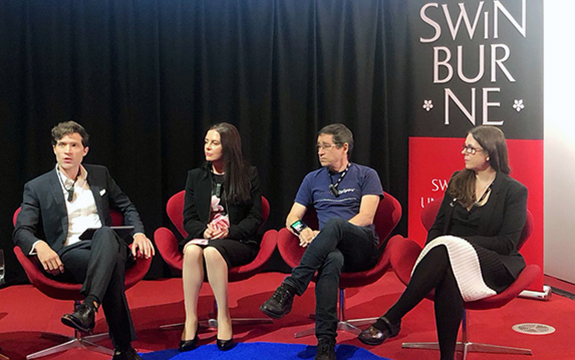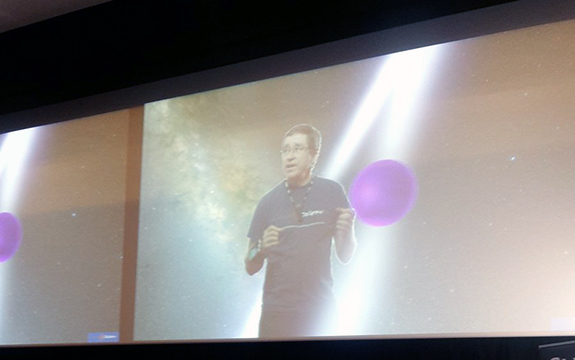Swinburne and Victorian Chamber of Commerce launch businesses into space

In Summary
- Swinburne partnered with the Victorian Chamber of Commerce and Industry for an event to foster Victoria’s industry-linked innovation and research
Swinburne researchers are at the forefront of the rapidly emerging Australian space sector.
On Tuesday 19 February, Swinburne partnered with the Victorian Chamber of Commerce and Industry (VCCI) to host an ‘ignite’ event themed ‘Space Tech – the new Australian industry’.
Hosted by astrophysicist, Associate Professor Alan Duffy, the event aimed to highlight, encourage and foster Victoria’s industry-linked innovation and research capabilities.
Swinburne experts, Professors Virginia Kilborn, Bronwyn Fox and Matthew Bailes, delved into the world of space to demonstrate how it is enabling Australian industry to access global value chains through advanced technology innovation.
“Space is a $400 billion-dollar worldwide industry which continues to grow,” said the VCCI’s Chief Executive Mark Stone AM.
“Victorian businesses are already renowned for their expertise in satellite navigation, data analysis and manufacturing capabilities. If we want to remain competitive, we need to leverage our already strong skill-set and seize more opportunities within this booming billion-dollar industry.
Swinburne’s Vice-Chancellor Professor Linda Kristjanson AO said research into space technology and the resulting practical application has unlimited potential for social and economic impact.
“We are no longer on the cusp of an industrial revolution, we are at the centre. The rapid digital transformation of the manufacturing industry, or Industry 4.0, will influence the future of industry, the workforce and society.
“Helping our partners move into the burgeoning international space market is the natural extension of our current capabilities and knowledge.”
Technology-driven space race
Recalling the historic moon landing 50 years ago, Professor Virginia Kilborn, who leads Swinburne’s Space Office, said that the current space race is being driven by huge advances in technology and manufacturing.
She said Swinburne is working with other universities on the SkyHopper Q satellite, which is Australia’s first space telescope designed to look for gamma ray bursts, distant galaxies and planets orbiting nearby stars.
One of the most exciting projects Professor Kilborn is involved with is the SHINE experiment with Haileybury school, where students design an experiment to be conducted in space. This year’s project will see a tooth sent to the International Space Station to measure how teeth decay in space compared to on earth.
Carbon fibre composites and graphene
The Director of Swinburne’s Manufacturing Futures Research Institute, Professor Bronwyn Fox, discussed the world-first technology Swinburne is developing with industry partners that is focused on space age materials, 3D printing them and the digitalisation of those materials.
She said carbon fibre composite materials are revolutionising the aerospace industry, and are being used in the Boeing 787 Dreamliner fuselage. However the hi-tech material is too slow to make and wasteful to produce.
Swinburne is working with Austrian company Fill on more efficient ways of making carbon fibre composites.
The university is also working on the potential of graphene as a smart material that could be the ‘eyes and ears’ on a spacecraft, detecting changes in pressure, humidity, temperature and fuel leaks.
“We are working with carbon-based materials such as graphene and carbon fibre and combining them together. By making them faster and cheaper and reducing weight we are making really great strides to ensure that space missions and satellite launches are both more cost-effective and safer,” Professor Fox said.
“Here on the ground at Swinburne we are working on space age technology that will have a real impact on the Australian manufacturing sector and we are creating a world-first unique process for 3D printing of these highly engineered carbon fibre composite materials.”
Tour of the Universe
As the Director of OzGrav, Professor Matthew Bailes is leading Australia's foray into the new field of gravitational wave astrophysics. He used a combination of animations and virtual reality technologies to bring this science to life in his presentation.
 Professor Matthew Bailes is leading Australia's foray into the new field of gravitational wave astrophysics.
Professor Matthew Bailes is leading Australia's foray into the new field of gravitational wave astrophysics.
This exciting new field takes the gravitational pulse of the Universe using the most sophisticated listening device ever conceived Advanced Laser Interferometer Gravitational-Wave Observatory (LIGO), and witnesses the destruction of pairs of black holes and neutron star binaries in the distant Universe.
To find out how to partner with Swinburne’s space and technology experts, email engage@swin.edu.au

